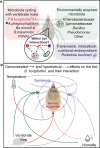The environment, the tick, and the pathogen - It is an ensemble
- PMID: 36405964
- PMCID: PMC9666722
- DOI: 10.3389/fcimb.2022.1049646
The environment, the tick, and the pathogen - It is an ensemble
Abstract
Ixodes scapularis is one of the predominant vectors of Borrelia burgdorferi, the agent of Lyme disease in the USA. The geographic distribution of I. scapularis, endemic to the northeastern and northcentral USA, is expanding as far south as Georgia and Texas, and northwards into Canada and poses an impending public health problem. The prevalence and spread of tick-borne diseases are influenced by the interplay of multiple factors including microbiological, ecological, and environmental. Molecular studies have focused on interactions between the tick-host and pathogen/s that determine the success of pathogen acquisition by the tick and transmission to the mammalian host. In this review we draw attention to additional critical environmental factors that impact tick biology and tick-pathogen interactions. With a focus on B. burgdorferi we highlight the interplay of abiotic factors such as temperature and humidity as well as biotic factors such as environmental microbiota that ticks are exposed to during their on- and off-host phases on tick, and infection prevalence. A molecular understanding of this ensemble of interactions will be essential to gain new insights into the biology of tick-pathogen interactions and to develop new approaches to control ticks and tick transmission of B. burgdorferi, the agent of Lyme disease.
Keywords: Borrelia burgdorferi; Ixodes scapularis; environmental factors; microbiome; tick.
Copyright © 2022 Couret, Schofield and Narasimhan.
Conflict of interest statement
The authors declare that the research was conducted in the absence of any commercial or financial relationships that could be construed as a potential conflict of interest.
Figures

Similar articles
-
Multiomics Reveals Symbionts, Pathogens, and Tissue-Specific Microbiome of Blacklegged Ticks (Ixodes scapularis) from a Lyme Disease Hot Spot in Southeastern Ontario, Canada.Microbiol Spectr. 2023 Jun 15;11(3):e0140423. doi: 10.1128/spectrum.01404-23. Epub 2023 May 15. Microbiol Spectr. 2023. PMID: 37184407 Free PMC article.
-
Species distribution models for the eastern blacklegged tick, Ixodes scapularis, and the Lyme disease pathogen, Borrelia burgdorferi, in Ontario, Canada.PLoS One. 2020 Sep 11;15(9):e0238126. doi: 10.1371/journal.pone.0238126. eCollection 2020. PLoS One. 2020. PMID: 32915794 Free PMC article.
-
Tick transmission of Borrelia burgdorferi to the murine host is not influenced by environmentally acquired midgut microbiota.Microbiome. 2022 Oct 17;10(1):173. doi: 10.1186/s40168-022-01378-w. Microbiome. 2022. PMID: 36253842 Free PMC article.
-
The role of Ixodes scapularis, Borrelia burgdorferi and wildlife hosts in Lyme disease prevalence: A quantitative review.Ticks Tick Borne Dis. 2018 Jul;9(5):1103-1114. doi: 10.1016/j.ttbdis.2018.04.006. Epub 2018 Apr 16. Ticks Tick Borne Dis. 2018. PMID: 29680260 Review.
-
[Ixodes ricinus, transmitted diseases and reservoirs].Parassitologia. 2004 Jun;46(1-2):119-22. Parassitologia. 2004. PMID: 15305699 Review. Italian.
Cited by
-
Microbial community characteristics and pathogens detection in Rhipicephalus sanguineus and Haemaphysalis hystricis from Hainan Island, China.Front Microbiol. 2024 Oct 8;15:1450219. doi: 10.3389/fmicb.2024.1450219. eCollection 2024. Front Microbiol. 2024. PMID: 39439943 Free PMC article.
-
The Prevalence of Tick-Borne Encephalitis Virus in the Ticks and Humans of China from 2000 to 2023: A Systematic Review and Meta-Analysis.Vet Sci. 2025 Feb 8;12(2):146. doi: 10.3390/vetsci12020146. Vet Sci. 2025. PMID: 40005906 Free PMC article. Review.
-
In Vitro Detection of Acaricide Resistance in Hyalomma Species Ticks with Emphasis on Farm Management Practices Associated with Acaricide Resistance in Abu Dhabi, United Arab Emirates.Vet Sci. 2025 Jul 29;12(8):712. doi: 10.3390/vetsci12080712. Vet Sci. 2025. PMID: 40872663 Free PMC article.
-
Diversity of species and geographic distribution of tick-borne viruses in China.Front Microbiol. 2024 Feb 27;15:1309698. doi: 10.3389/fmicb.2024.1309698. eCollection 2024. Front Microbiol. 2024. PMID: 38476950 Free PMC article.
-
Prevalence of Lyme Disease and Relapsing Fever Borrelia spp. in Vectors, Animals, and Humans within a One Health Approach in Mediterranean Countries.Pathogens. 2024 Jun 17;13(6):512. doi: 10.3390/pathogens13060512. Pathogens. 2024. PMID: 38921809 Free PMC article. Review.
References
-
- Arsnoe I. M., Hickling G. J., Ginsberg H. S., McElreath R., Tsao J. I. (2015). Different populations of blacklegged tick nymphs exhibit differences in questing behavior that have implications for human lyme disease risk. PloS One 10 (5), e0127450. doi: 10.1371/journal.pone.0127450 - DOI - PMC - PubMed
Publication types
MeSH terms
Grants and funding
LinkOut - more resources
Full Text Sources
Medical

